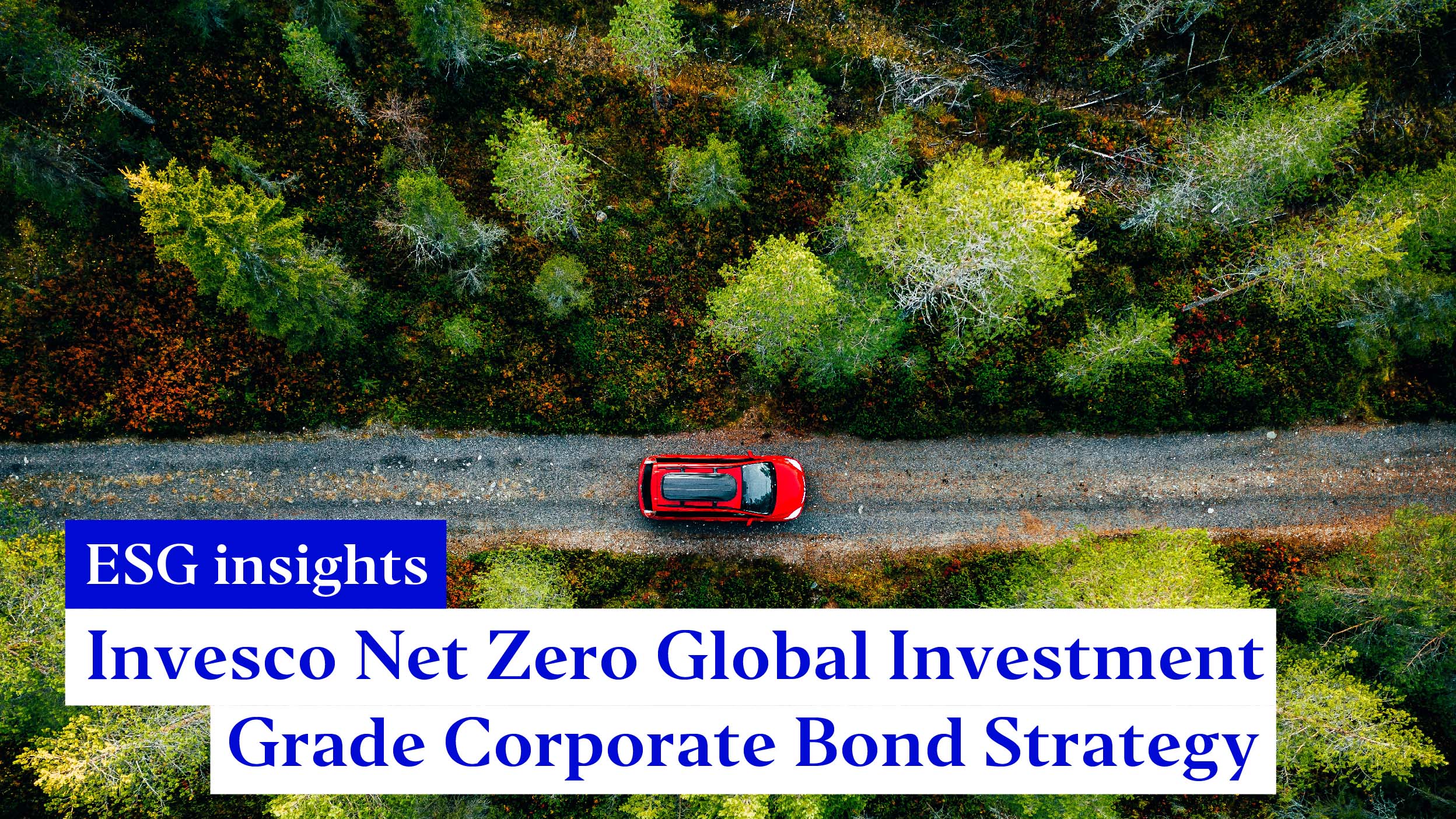
Investing in fixed income
Whether you’re looking for income, diversification, capital preservation or total returns, we have the strategies, the scale and the flexibility needed to match your objectives as markets evolve.

Achieving net zero emissions by 2050 is the principle environmental goal globally. As you can see from Figure 1, the world still has a way to go.
If you break the data down further, you will find that large corporates are estimated to account for around 20% of global emissions. This means that companies in all sectors and geographies will need to decarbonise if the world is to achieve its target.
The challenge ahead is a significant one. However, ongoing improvements in the availability and quality of corporate emissions data are making this objective increasingly achievable. This is particularly important to us, not only as corporate bond investors, but as managers of a net zero strategy.
Source: bp Statistical Review of World Energy 2022, Refinitiv Datastream and Invesco.
The Invesco Net Zero Global Investment Grade Corporate Bond Strategy (“the strategy”) launched in June of 2022 after nearly two years in development. During this time, we sought to design a strategy that would support an orderly transition to a carbon free economy.
At its core, our approach works with the Net Zero Investment Framework developed by the Paris Aligned Investor Initiative (PAII). This guides asset owners as they evaluate whether companies are aligning to or already aligned with net zero goals. It also helps them set portfolio alignment targets.
Implementing a net zero framework is no mean feat. The practical and operational challenges are large and require skilled active management.
As part of our investment process, we assess each issuer in our investment universe to see whether they are on track to achieve net zero emissions by 2050 or sooner. This allows us to build a detailed picture of those companies that are suitable for purchase.
Not all companies need to be fully aligned on day one. We recognise that different industries will decarbonise at different rates. Our aim is to identify those companies that demonstrate the strongest ability and desire to achieve net zero.
Given this, we do not exclude high-emitting sectors. Instead, we finance those companies that are publicly committed to net zero that we believe can make meaningful progress, while constantly assessing their development over time.
Ongoing oversight is essential to ensuring that companies stay on track with short, medium and long-term objectives. To help bring this process to life, we share a case study on an issuer currently held in the strategy.
Headquartered in Italy, Enel SpA is a leading European utility company. It generated a revenue of €84.1bn in 2021, accounting for ~16% of domestic power generation and 86% of power distribution. Enel is a high emitter. It is also one of the top holdings in the strategy.
Enel is the only company in the Climate Action 100+ Net Zero Company Benchmark to have been assessed as fully meeting all criteria, including the particularly high standards set for Capital Allocation Alignment. A blanket exclusion to high emitters would rule out our participation in Enel’s impressive transition plans.
In our most recent meeting with Enel, they outlined their extensive engagement with industry bodies including Climate Action 100+, the Transition Pathway Initiative and Carbon Tracker teams. They also engage with investors to understand their expectations.
Enel is the only utilities company which satisfies all criteria set out in our own Net Zero Investment Framework. We share further details below.
NZ Criteria |
Criteria Assessment (No/Partial/Full) |
Rationale |
|---|---|---|
Ambition |
Full |
The company brought its net zero commitment forward to 2040 across Scope 1, 2 and 3 emissions.1 It is committed to making a science-based target aligned with SBTI’s target setting criteria. |
Targets |
Full |
The company has set the following short and medium-term emissions targets: Short term
Medium term
|
Emissions Performance |
Full |
The company has reduced its Scope 1 emissions by almost 50% since 2017. In 2017, it emitted 414g/kw and in 2021, this was down to 227g/kw. Source: SBTI Progress Dashboard. |
Disclosure |
Full |
The company discloses all three scopes. |
Decarbonisation Strategy |
Full |
Enel’s strategy focuses on closing coal plants and ramping up renewable generation. The company is aiming to exit coal in Italy by 2025, and globally by 2027. |
Capital Allocation |
Full |
Enel has worked with leading industry standards (TPI and Carbon Tracker) to align its capital spending with best practices. In 2021, 94% of Enel’s total capital expenditure was in low-carbon products, services and technologies. |
Just Transition |
No assessment criteria currently, but sector leader |
Enel is planning for the closure of numerous coal plants, and has set targets for reskilling and redeploying its workforce into renewables. |
Engaging with companies is an essential part of our investment process. It helps us understand the reality they are facing as they attempt to deliver on their climate commitments. It also provides a forum for us to seek answers, where progress has fallen short of expectations.
Our net zero engagement goals encourage companies to take continuous and incremental steps forward in their decarbonisation strategy. A recent example occurred in February, when we met with the Chairman of a large European building materials company.
Given the nature of the company’s business, we discussed a number of ESG topics. Our alignment assessment had previously labelled them as “aligning”, and we wanted to make sure we still had conviction in this.
During the discussion, we emphasised the importance of the absolute emissions reduction target they had set under the Science Based Targets Initiative (SBTi). We acknowledged that it showed a strong ambition to decarbonise, as they had been required to use 2020 as their base year. This was a lower emissions year, as COVID disruptions suppressed activity levels.
Cement forms part of the company’s core business – a hard activity to abate. However, when we explored their determination to meet the commitments, we were reassured. The adoption of these targets is being driven at the board level, and they are cognisant of the level of investment required. This is currently estimated at $150 million per year until 2030.
Furthermore, the company has struck new partnerships to develop carbon capture technologies. It is also looking at methods it can use to lower the use of clinker when producing cement. This is a major component in cement’s carbon footprint.
Finally, the company stated that it is in the process of getting its 1.5 degree climate targets signed off by SBTi for the cement business. Its climate reporting already conforms to TCFD and EU Taxonomy recommendations.
The company is, in our view, a little behind certain peers in terms of implementing measures like carbon capture. However, we are comfortable that it has a roadmap towards becoming carbon neutral by 2050.
Looking ahead, our next engagement with the company will focus on any progress they have made against their decarbonisation roadmap. Sensibly, this has a substantial focus on what can be done using existing technology. This includes initiatives like changing the mix of clinker to reduce CO2, and continuing with recycling projects.
Net zero aligned investing is relatively new and therefore, evolving rapidly. As such, we regularly review our implementation of the Net Zero Investment Framework to identify areas for improvement.
Currently, one topic of particular focus is the application of the framework to banks. Given their importance in reducing the financing of high emitting industries, banks can be classified as high emitters. Their role in providing capital to climate solutions further elevates their importance in supporting an orderly transition.
Due to the nature of their business, the majority of banks’ emissions are indirect (Scope 3). This makes assessing their alignment particularly complex and commitment based. Our initial approach was binary and focused only on whether a bank had publicly committed to net zero targets or not.
We have since worked to enhance our assessment framework by defining the criteria that a bank would need to meet to be evaluated as moving to implementation, before ultimately becoming fully aligned with a net zero pathway.
Our extended framework focus on ensuring that targets and disclosures from banks meet the highest standards set by the various carbon commitment bodies – think Science Based Targets, Greenhouse Gas Protocol, Carbon Disclosure Project, and the Partnership for Carbon Accounting Financials. These common frameworks are helpful as they allow comparison. Furthermore, they provide us with the detail needed to monitor a company’s adherence to net zero principles.
We also set ambitious criteria around green financing levels relative to non-green, which link to the need for a step-change in climate mitigation and adaptation financing to meet the urgency of climate action this decade. Encouragingly, we find that some global banks are making meaningful progress on alignment against our criteria.
The strategy is now almost a year old and, as we have outlined above, there has been lots to keep us busy. That won’t change going forwards, as new challenges and opportunities unfold in the net zero investment space.
To wrap this piece up, we leave you with some of the key takeaways from the latest assessment report from the UN Intergovernmental Panel on Climate Change. This again sounded the alarm that the 1.5°C scenario could be slipping out of reach. It also stated that finance for climate mitigation would need to increase by a factor of six. If the world is to reach its net zero targets, investors will play a big role in financing the transition.

Bond markets struggled in March, primarily due to concerns about the potential impact of upcoming US policies. Read our latest thoughts on how fixed income markets fared during the month and what we think you should be looking out for in the near term.

In our regularly updated macroeconomic analysis we offer an outlook for interest rates and currencies – and look at which fixed income assets are favoured across a range of market environments.

Significant focus on the uncertainty of the US macroeconomic backdrop and its potential headwinds on the market remain top of mind for investment opportunities globally. Against this cautious outlook, we asked the experts from Invesco’s bank loan, direct lending and distressed credit teams to share their views as the first quarter of 2025 begins.
1 Scope 1 emissions are direct (e.g. the emissions generated by a company in its day-to-day operations). Scope 2 emissions are indirect (e.g. the emissions indirectly generated by a company when it uses electricity). Scope 3 emissions are more indirect still (e.g. the emissions generated throughout the value chain of the reporting company).
Debt instruments are exposed to credit risk which is the ability of the borrower to repay the interest and capital on the redemption date.
Changes in interest rates will result in fluctuations in the value of the strategy.
The strategy uses derivatives (complex instruments) for investment purposes, which may result in the strategy being significantly leveraged and may result in large fluctuations in the value of the strategy.
The strategy may invest in certain securities listed in China which can involve significant regulatory constraints that may affect the liquidity and/or the investment performance of the strategy.
As this strategy is invested in a particular sector, you should be prepared to accept greater fluctuations in the value of the strategy than for a strategy with a broader investment mandate.
The strategy may invest in contingent convertible bonds which may result in significant risk of capital loss based on certain trigger events.
The lack of common standards may result in different approaches to setting and achieving ESG objectives. In addition, the respect of the ESG criteria may cause the strategy to forego certain investment opportunities.
Data is as at 31 March 2023, sourced from Invesco unless otherwise stated.
This is marketing material and not financial advice. It is not intended as a recommendation to buy or sell any particular asset class, security or strategy. Regulatory requirements that require impartiality of investment/investment strategy recommendations are therefore not applicable nor are any prohibitions to trade before publication. Views and opinions are based on current market conditions and are subject to change.